Comprehensive Analysis of Management Accounting for Galway Plc
VerifiedAdded on 2021/02/19
|14
|5174
|45
Report
AI Summary
This report provides a comprehensive analysis of management accounting principles and practices, focusing on their application within Galway Plc. It begins by defining management accounting and outlining its essential requirements, including cost accounting, inventory management, job costing, and price optimization systems. The report then explores various reporting methods used in management accounting, such as budget reports, performance reports, accounts receivable reports, and cost management reports. A significant portion of the report is dedicated to the calculation of income statements under both marginal and absorption costing methods, providing detailed examples for May and June. It also examines the advantages and disadvantages of different planning tools used for budgetary control and discusses how management accounting systems can be used to respond to financial problems. The report concludes by emphasizing the role of management accounting in achieving organizational success and includes detailed financial calculations and comparisons to illustrate key concepts.
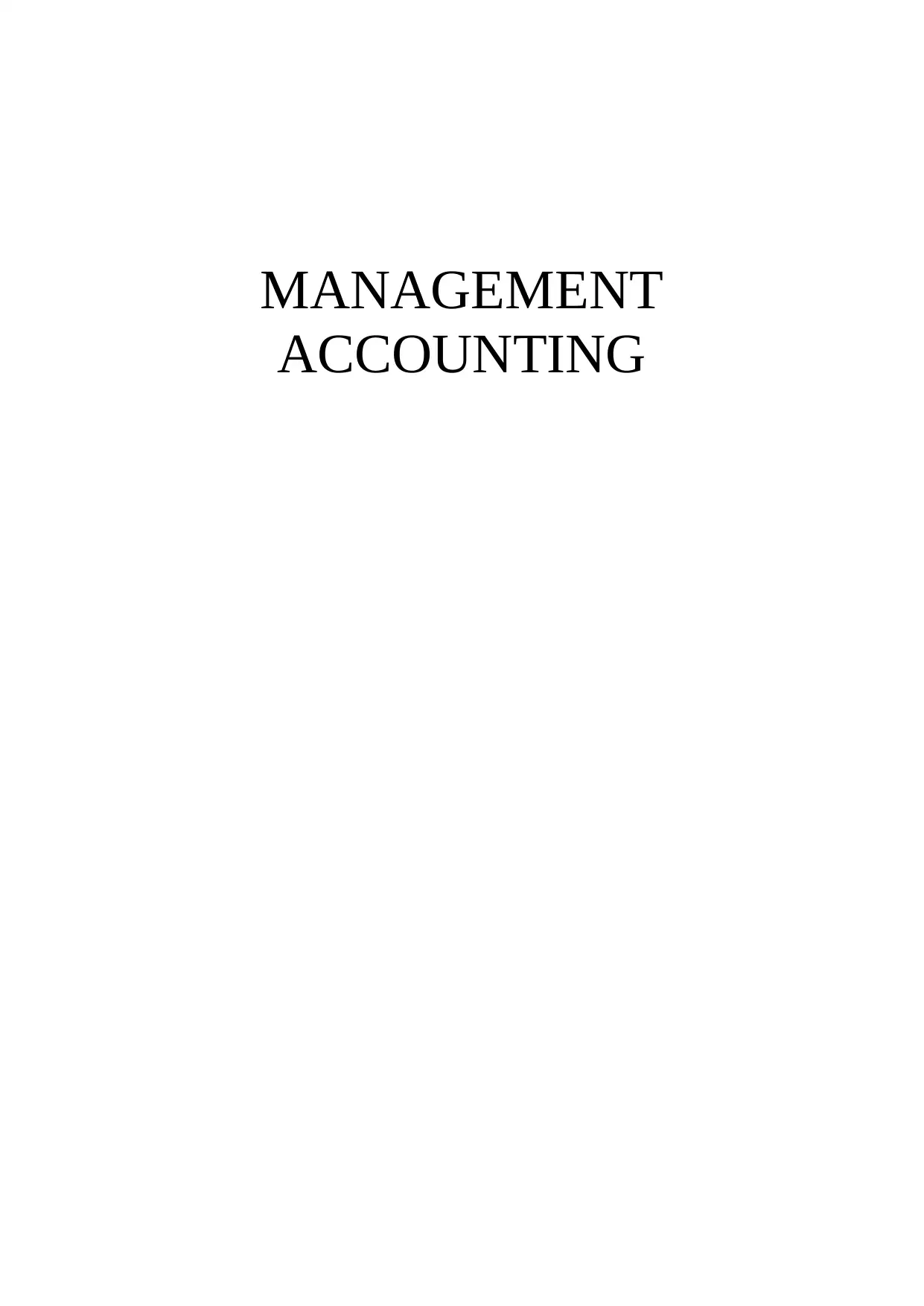
MANAGEMENT
ACCOUNTING
ACCOUNTING
Paraphrase This Document
Need a fresh take? Get an instant paraphrase of this document with our AI Paraphraser
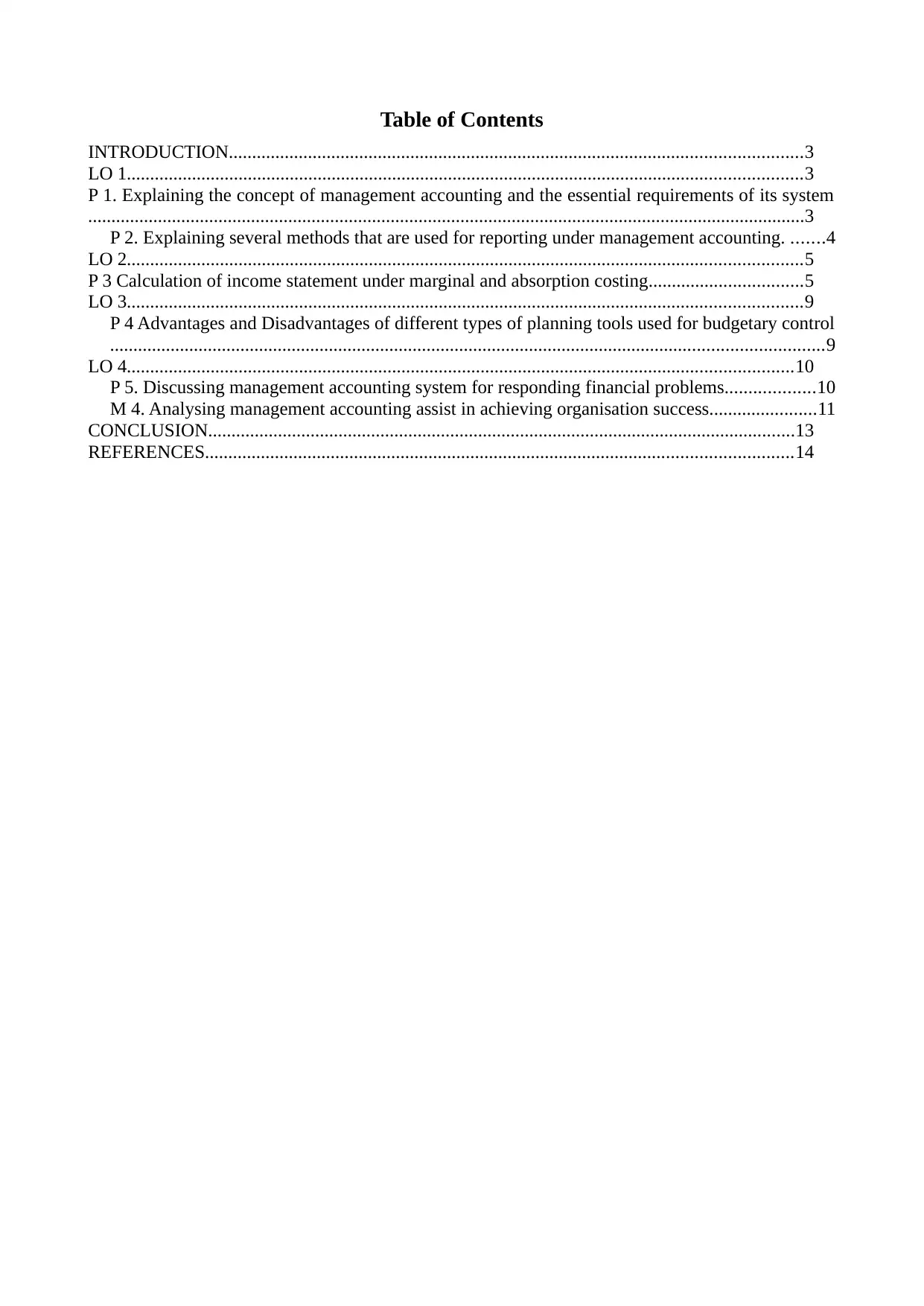
Table of Contents
INTRODUCTION...........................................................................................................................3
LO 1.................................................................................................................................................3
P 1. Explaining the concept of management accounting and the essential requirements of its system
..........................................................................................................................................................3
P 2. Explaining several methods that are used for reporting under management accounting. .......4
LO 2.................................................................................................................................................5
P 3 Calculation of income statement under marginal and absorption costing.................................5
LO 3.................................................................................................................................................9
P 4 Advantages and Disadvantages of different types of planning tools used for budgetary control
.........................................................................................................................................................9
LO 4...............................................................................................................................................10
P 5. Discussing management accounting system for responding financial problems...................10
M 4. Analysing management accounting assist in achieving organisation success.......................11
CONCLUSION..............................................................................................................................13
REFERENCES..............................................................................................................................14
INTRODUCTION...........................................................................................................................3
LO 1.................................................................................................................................................3
P 1. Explaining the concept of management accounting and the essential requirements of its system
..........................................................................................................................................................3
P 2. Explaining several methods that are used for reporting under management accounting. .......4
LO 2.................................................................................................................................................5
P 3 Calculation of income statement under marginal and absorption costing.................................5
LO 3.................................................................................................................................................9
P 4 Advantages and Disadvantages of different types of planning tools used for budgetary control
.........................................................................................................................................................9
LO 4...............................................................................................................................................10
P 5. Discussing management accounting system for responding financial problems...................10
M 4. Analysing management accounting assist in achieving organisation success.......................11
CONCLUSION..............................................................................................................................13
REFERENCES..............................................................................................................................14
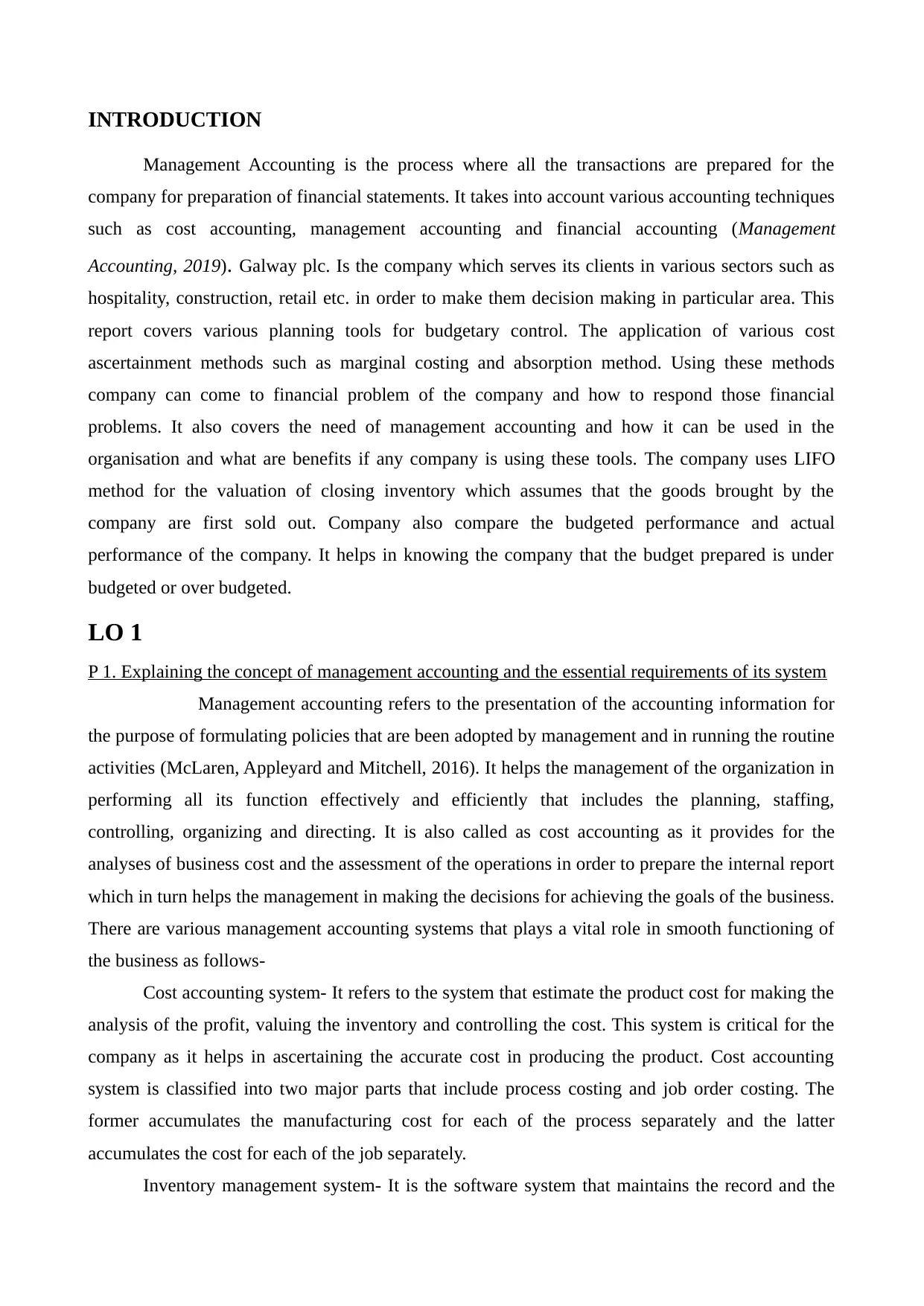
INTRODUCTION
Management Accounting is the process where all the transactions are prepared for the
company for preparation of financial statements. It takes into account various accounting techniques
such as cost accounting, management accounting and financial accounting (Management
Accounting, 2019). Galway plc. Is the company which serves its clients in various sectors such as
hospitality, construction, retail etc. in order to make them decision making in particular area. This
report covers various planning tools for budgetary control. The application of various cost
ascertainment methods such as marginal costing and absorption method. Using these methods
company can come to financial problem of the company and how to respond those financial
problems. It also covers the need of management accounting and how it can be used in the
organisation and what are benefits if any company is using these tools. The company uses LIFO
method for the valuation of closing inventory which assumes that the goods brought by the
company are first sold out. Company also compare the budgeted performance and actual
performance of the company. It helps in knowing the company that the budget prepared is under
budgeted or over budgeted.
LO 1
P 1. Explaining the concept of management accounting and the essential requirements of its system
Management accounting refers to the presentation of the accounting information for
the purpose of formulating policies that are been adopted by management and in running the routine
activities (McLaren, Appleyard and Mitchell, 2016). It helps the management of the organization in
performing all its function effectively and efficiently that includes the planning, staffing,
controlling, organizing and directing. It is also called as cost accounting as it provides for the
analyses of business cost and the assessment of the operations in order to prepare the internal report
which in turn helps the management in making the decisions for achieving the goals of the business.
There are various management accounting systems that plays a vital role in smooth functioning of
the business as follows-
Cost accounting system- It refers to the system that estimate the product cost for making the
analysis of the profit, valuing the inventory and controlling the cost. This system is critical for the
company as it helps in ascertaining the accurate cost in producing the product. Cost accounting
system is classified into two major parts that include process costing and job order costing. The
former accumulates the manufacturing cost for each of the process separately and the latter
accumulates the cost for each of the job separately.
Inventory management system- It is the software system that maintains the record and the
Management Accounting is the process where all the transactions are prepared for the
company for preparation of financial statements. It takes into account various accounting techniques
such as cost accounting, management accounting and financial accounting (Management
Accounting, 2019). Galway plc. Is the company which serves its clients in various sectors such as
hospitality, construction, retail etc. in order to make them decision making in particular area. This
report covers various planning tools for budgetary control. The application of various cost
ascertainment methods such as marginal costing and absorption method. Using these methods
company can come to financial problem of the company and how to respond those financial
problems. It also covers the need of management accounting and how it can be used in the
organisation and what are benefits if any company is using these tools. The company uses LIFO
method for the valuation of closing inventory which assumes that the goods brought by the
company are first sold out. Company also compare the budgeted performance and actual
performance of the company. It helps in knowing the company that the budget prepared is under
budgeted or over budgeted.
LO 1
P 1. Explaining the concept of management accounting and the essential requirements of its system
Management accounting refers to the presentation of the accounting information for
the purpose of formulating policies that are been adopted by management and in running the routine
activities (McLaren, Appleyard and Mitchell, 2016). It helps the management of the organization in
performing all its function effectively and efficiently that includes the planning, staffing,
controlling, organizing and directing. It is also called as cost accounting as it provides for the
analyses of business cost and the assessment of the operations in order to prepare the internal report
which in turn helps the management in making the decisions for achieving the goals of the business.
There are various management accounting systems that plays a vital role in smooth functioning of
the business as follows-
Cost accounting system- It refers to the system that estimate the product cost for making the
analysis of the profit, valuing the inventory and controlling the cost. This system is critical for the
company as it helps in ascertaining the accurate cost in producing the product. Cost accounting
system is classified into two major parts that include process costing and job order costing. The
former accumulates the manufacturing cost for each of the process separately and the latter
accumulates the cost for each of the job separately.
Inventory management system- It is the software system that maintains the record and the
⊘ This is a preview!⊘
Do you want full access?
Subscribe today to unlock all pages.

Trusted by 1+ million students worldwide
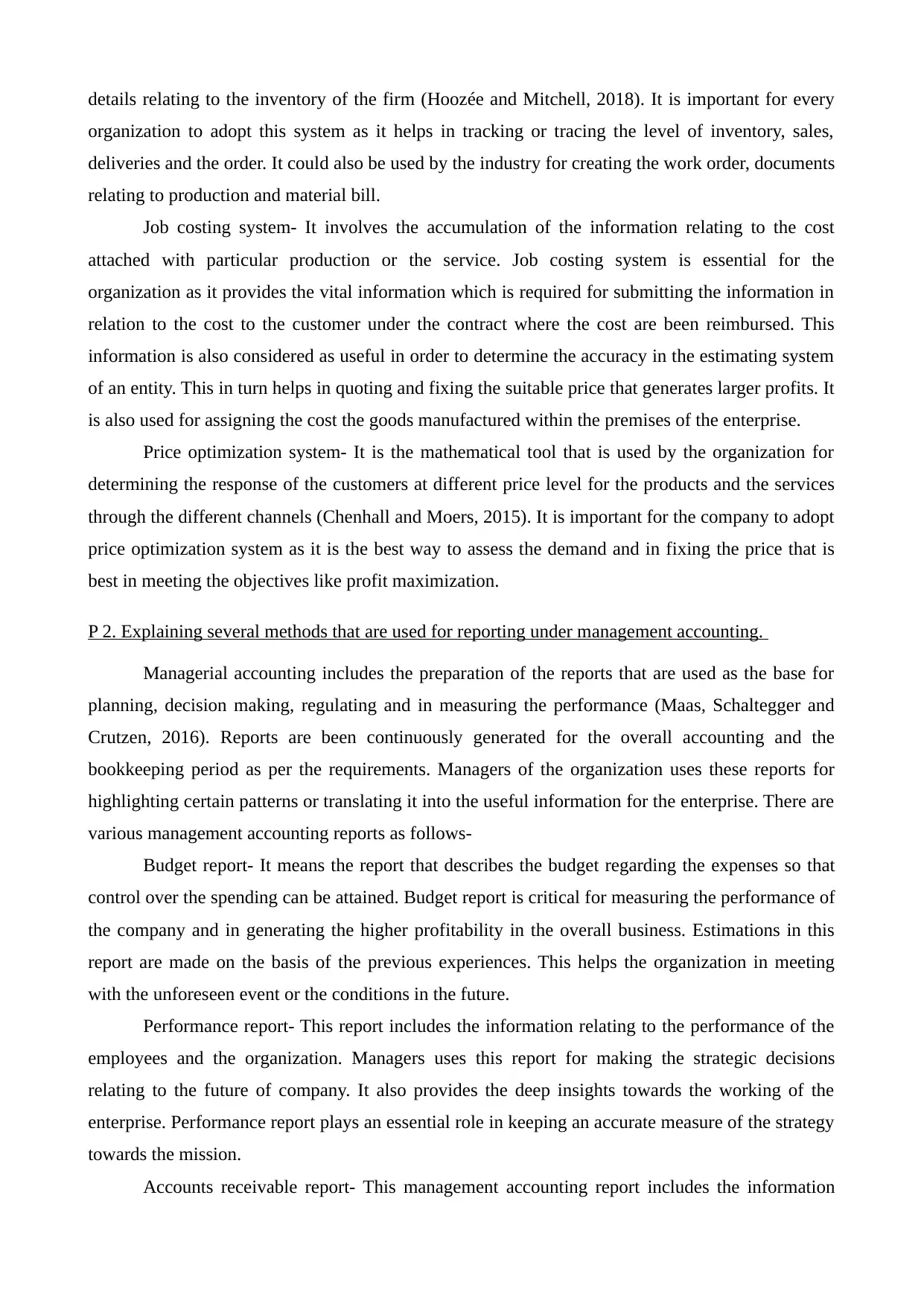
details relating to the inventory of the firm (Hoozée and Mitchell, 2018). It is important for every
organization to adopt this system as it helps in tracking or tracing the level of inventory, sales,
deliveries and the order. It could also be used by the industry for creating the work order, documents
relating to production and material bill.
Job costing system- It involves the accumulation of the information relating to the cost
attached with particular production or the service. Job costing system is essential for the
organization as it provides the vital information which is required for submitting the information in
relation to the cost to the customer under the contract where the cost are been reimbursed. This
information is also considered as useful in order to determine the accuracy in the estimating system
of an entity. This in turn helps in quoting and fixing the suitable price that generates larger profits. It
is also used for assigning the cost the goods manufactured within the premises of the enterprise.
Price optimization system- It is the mathematical tool that is used by the organization for
determining the response of the customers at different price level for the products and the services
through the different channels (Chenhall and Moers, 2015). It is important for the company to adopt
price optimization system as it is the best way to assess the demand and in fixing the price that is
best in meeting the objectives like profit maximization.
P 2. Explaining several methods that are used for reporting under management accounting.
Managerial accounting includes the preparation of the reports that are used as the base for
planning, decision making, regulating and in measuring the performance (Maas, Schaltegger and
Crutzen, 2016). Reports are been continuously generated for the overall accounting and the
bookkeeping period as per the requirements. Managers of the organization uses these reports for
highlighting certain patterns or translating it into the useful information for the enterprise. There are
various management accounting reports as follows-
Budget report- It means the report that describes the budget regarding the expenses so that
control over the spending can be attained. Budget report is critical for measuring the performance of
the company and in generating the higher profitability in the overall business. Estimations in this
report are made on the basis of the previous experiences. This helps the organization in meeting
with the unforeseen event or the conditions in the future.
Performance report- This report includes the information relating to the performance of the
employees and the organization. Managers uses this report for making the strategic decisions
relating to the future of company. It also provides the deep insights towards the working of the
enterprise. Performance report plays an essential role in keeping an accurate measure of the strategy
towards the mission.
Accounts receivable report- This management accounting report includes the information
organization to adopt this system as it helps in tracking or tracing the level of inventory, sales,
deliveries and the order. It could also be used by the industry for creating the work order, documents
relating to production and material bill.
Job costing system- It involves the accumulation of the information relating to the cost
attached with particular production or the service. Job costing system is essential for the
organization as it provides the vital information which is required for submitting the information in
relation to the cost to the customer under the contract where the cost are been reimbursed. This
information is also considered as useful in order to determine the accuracy in the estimating system
of an entity. This in turn helps in quoting and fixing the suitable price that generates larger profits. It
is also used for assigning the cost the goods manufactured within the premises of the enterprise.
Price optimization system- It is the mathematical tool that is used by the organization for
determining the response of the customers at different price level for the products and the services
through the different channels (Chenhall and Moers, 2015). It is important for the company to adopt
price optimization system as it is the best way to assess the demand and in fixing the price that is
best in meeting the objectives like profit maximization.
P 2. Explaining several methods that are used for reporting under management accounting.
Managerial accounting includes the preparation of the reports that are used as the base for
planning, decision making, regulating and in measuring the performance (Maas, Schaltegger and
Crutzen, 2016). Reports are been continuously generated for the overall accounting and the
bookkeeping period as per the requirements. Managers of the organization uses these reports for
highlighting certain patterns or translating it into the useful information for the enterprise. There are
various management accounting reports as follows-
Budget report- It means the report that describes the budget regarding the expenses so that
control over the spending can be attained. Budget report is critical for measuring the performance of
the company and in generating the higher profitability in the overall business. Estimations in this
report are made on the basis of the previous experiences. This helps the organization in meeting
with the unforeseen event or the conditions in the future.
Performance report- This report includes the information relating to the performance of the
employees and the organization. Managers uses this report for making the strategic decisions
relating to the future of company. It also provides the deep insights towards the working of the
enterprise. Performance report plays an essential role in keeping an accurate measure of the strategy
towards the mission.
Accounts receivable report- This management accounting report includes the information
Paraphrase This Document
Need a fresh take? Get an instant paraphrase of this document with our AI Paraphraser
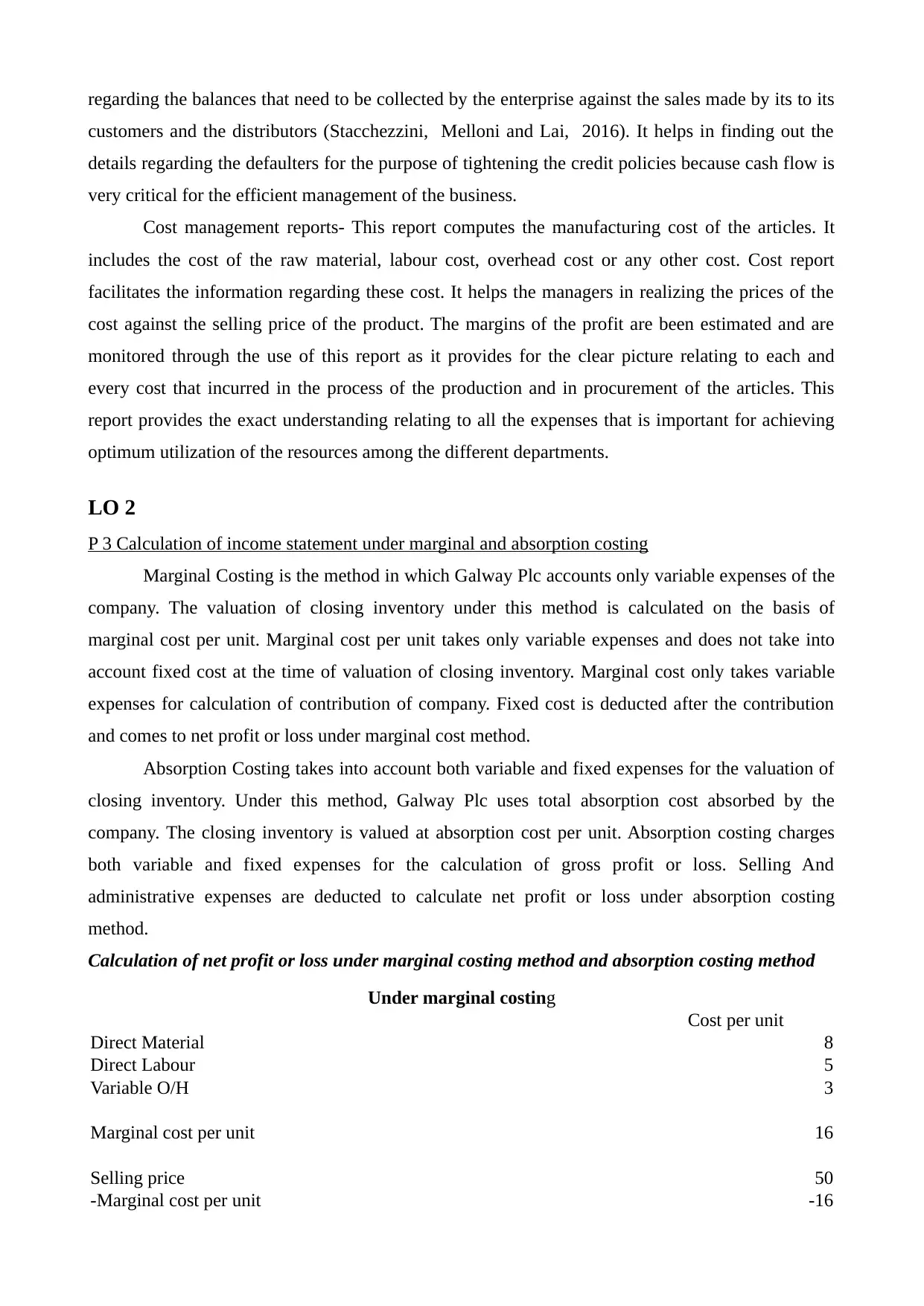
regarding the balances that need to be collected by the enterprise against the sales made by its to its
customers and the distributors (Stacchezzini, Melloni and Lai, 2016). It helps in finding out the
details regarding the defaulters for the purpose of tightening the credit policies because cash flow is
very critical for the efficient management of the business.
Cost management reports- This report computes the manufacturing cost of the articles. It
includes the cost of the raw material, labour cost, overhead cost or any other cost. Cost report
facilitates the information regarding these cost. It helps the managers in realizing the prices of the
cost against the selling price of the product. The margins of the profit are been estimated and are
monitored through the use of this report as it provides for the clear picture relating to each and
every cost that incurred in the process of the production and in procurement of the articles. This
report provides the exact understanding relating to all the expenses that is important for achieving
optimum utilization of the resources among the different departments.
LO 2
P 3 Calculation of income statement under marginal and absorption costing
Marginal Costing is the method in which Galway Plc accounts only variable expenses of the
company. The valuation of closing inventory under this method is calculated on the basis of
marginal cost per unit. Marginal cost per unit takes only variable expenses and does not take into
account fixed cost at the time of valuation of closing inventory. Marginal cost only takes variable
expenses for calculation of contribution of company. Fixed cost is deducted after the contribution
and comes to net profit or loss under marginal cost method.
Absorption Costing takes into account both variable and fixed expenses for the valuation of
closing inventory. Under this method, Galway Plc uses total absorption cost absorbed by the
company. The closing inventory is valued at absorption cost per unit. Absorption costing charges
both variable and fixed expenses for the calculation of gross profit or loss. Selling And
administrative expenses are deducted to calculate net profit or loss under absorption costing
method.
Calculation of net profit or loss under marginal costing method and absorption costing method
Under marginal costing
Cost per unit
Direct Material 8
Direct Labour 5
Variable O/H 3
Marginal cost per unit 16
Selling price 50
-Marginal cost per unit -16
customers and the distributors (Stacchezzini, Melloni and Lai, 2016). It helps in finding out the
details regarding the defaulters for the purpose of tightening the credit policies because cash flow is
very critical for the efficient management of the business.
Cost management reports- This report computes the manufacturing cost of the articles. It
includes the cost of the raw material, labour cost, overhead cost or any other cost. Cost report
facilitates the information regarding these cost. It helps the managers in realizing the prices of the
cost against the selling price of the product. The margins of the profit are been estimated and are
monitored through the use of this report as it provides for the clear picture relating to each and
every cost that incurred in the process of the production and in procurement of the articles. This
report provides the exact understanding relating to all the expenses that is important for achieving
optimum utilization of the resources among the different departments.
LO 2
P 3 Calculation of income statement under marginal and absorption costing
Marginal Costing is the method in which Galway Plc accounts only variable expenses of the
company. The valuation of closing inventory under this method is calculated on the basis of
marginal cost per unit. Marginal cost per unit takes only variable expenses and does not take into
account fixed cost at the time of valuation of closing inventory. Marginal cost only takes variable
expenses for calculation of contribution of company. Fixed cost is deducted after the contribution
and comes to net profit or loss under marginal cost method.
Absorption Costing takes into account both variable and fixed expenses for the valuation of
closing inventory. Under this method, Galway Plc uses total absorption cost absorbed by the
company. The closing inventory is valued at absorption cost per unit. Absorption costing charges
both variable and fixed expenses for the calculation of gross profit or loss. Selling And
administrative expenses are deducted to calculate net profit or loss under absorption costing
method.
Calculation of net profit or loss under marginal costing method and absorption costing method
Under marginal costing
Cost per unit
Direct Material 8
Direct Labour 5
Variable O/H 3
Marginal cost per unit 16
Selling price 50
-Marginal cost per unit -16

-variable selling price -2.50
Contribution per unit 31.50
May
Sales (300*50) 15000
Cost of sales:
Opening inventory 0
Material (500*8) 4000
Labour (500*5) 2500
Variable o/h (500*3) 1500
8000
-Closing inventory (200*16) -3200.00
-4800
10200
-Variable selling cost -750
Contribution 9450
-Fixed costs -4000
Actual Net profit/(Net Loss) 5450
June
Sales (500*50) 25000
Cost of sales:
Opening inventory (200*16) 3200
Material (380*8) 3040
Labour (380*5) 1900
Variable o/h (380*3) 1140
9280
-Closing inventory (80*16) -1280
-8000
17000
-Variable selling cost -1250
Contribution 15750
-Fixed costs -4000
Actual Net profit/(Net Loss) 11750
Under Absorption Costing
Cost per unit
Direct Material 8
Direct Labour 5
Variable O/H 3
Fixed o/h 10
Total absorption cost per unit 26
May
sales (300*50) 15000
Contribution per unit 31.50
May
Sales (300*50) 15000
Cost of sales:
Opening inventory 0
Material (500*8) 4000
Labour (500*5) 2500
Variable o/h (500*3) 1500
8000
-Closing inventory (200*16) -3200.00
-4800
10200
-Variable selling cost -750
Contribution 9450
-Fixed costs -4000
Actual Net profit/(Net Loss) 5450
June
Sales (500*50) 25000
Cost of sales:
Opening inventory (200*16) 3200
Material (380*8) 3040
Labour (380*5) 1900
Variable o/h (380*3) 1140
9280
-Closing inventory (80*16) -1280
-8000
17000
-Variable selling cost -1250
Contribution 15750
-Fixed costs -4000
Actual Net profit/(Net Loss) 11750
Under Absorption Costing
Cost per unit
Direct Material 8
Direct Labour 5
Variable O/H 3
Fixed o/h 10
Total absorption cost per unit 26
May
sales (300*50) 15000
⊘ This is a preview!⊘
Do you want full access?
Subscribe today to unlock all pages.

Trusted by 1+ million students worldwide
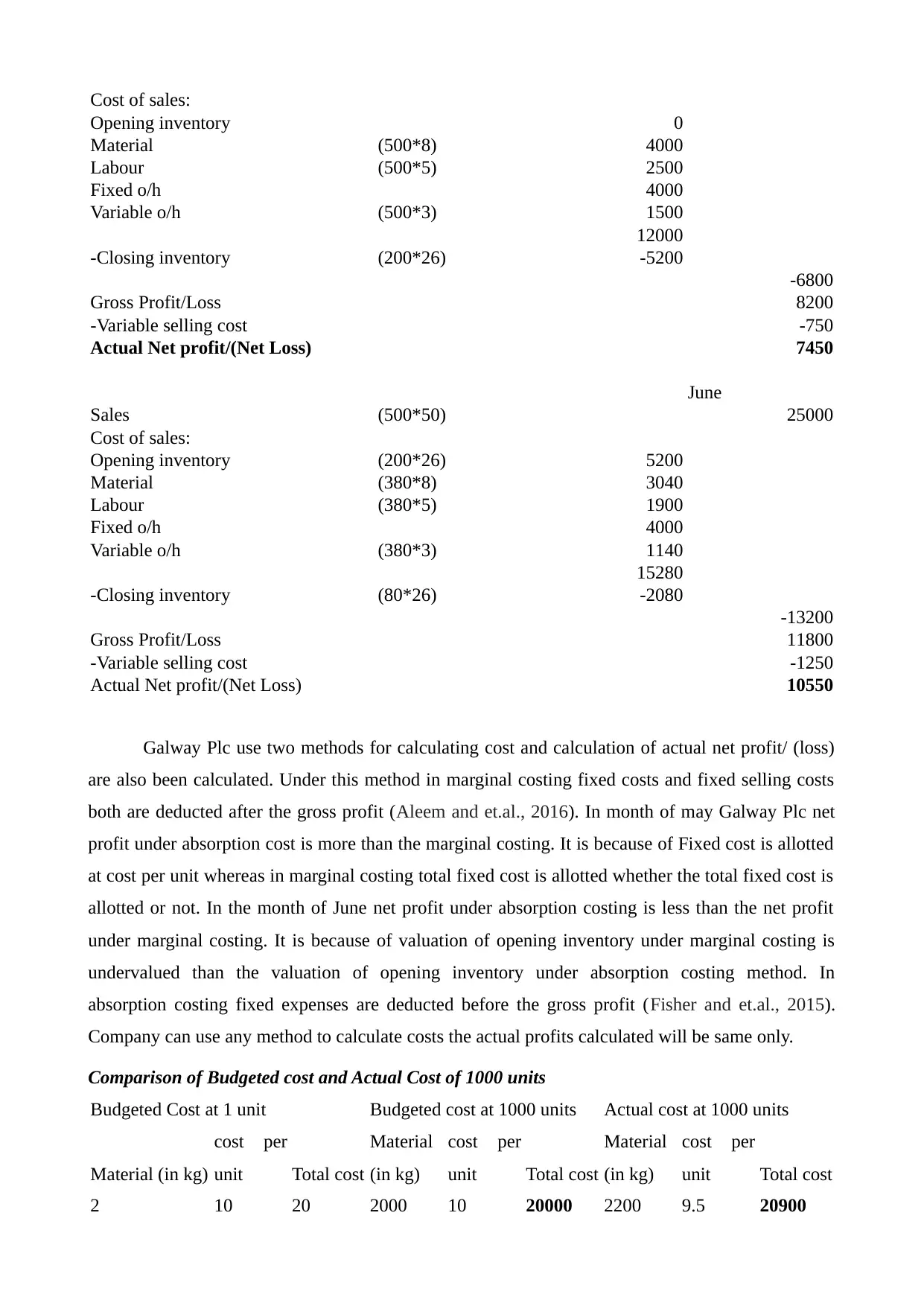
Cost of sales:
Opening inventory 0
Material (500*8) 4000
Labour (500*5) 2500
Fixed o/h 4000
Variable o/h (500*3) 1500
12000
-Closing inventory (200*26) -5200
-6800
Gross Profit/Loss 8200
-Variable selling cost -750
Actual Net profit/(Net Loss) 7450
June
Sales (500*50) 25000
Cost of sales:
Opening inventory (200*26) 5200
Material (380*8) 3040
Labour (380*5) 1900
Fixed o/h 4000
Variable o/h (380*3) 1140
15280
-Closing inventory (80*26) -2080
-13200
Gross Profit/Loss 11800
-Variable selling cost -1250
Actual Net profit/(Net Loss) 10550
Galway Plc use two methods for calculating cost and calculation of actual net profit/ (loss)
are also been calculated. Under this method in marginal costing fixed costs and fixed selling costs
both are deducted after the gross profit (Aleem and et.al., 2016). In month of may Galway Plc net
profit under absorption cost is more than the marginal costing. It is because of Fixed cost is allotted
at cost per unit whereas in marginal costing total fixed cost is allotted whether the total fixed cost is
allotted or not. In the month of June net profit under absorption costing is less than the net profit
under marginal costing. It is because of valuation of opening inventory under marginal costing is
undervalued than the valuation of opening inventory under absorption costing method. In
absorption costing fixed expenses are deducted before the gross profit (Fisher and et.al., 2015).
Company can use any method to calculate costs the actual profits calculated will be same only.
Comparison of Budgeted cost and Actual Cost of 1000 units
Budgeted Cost at 1 unit Budgeted cost at 1000 units Actual cost at 1000 units
Material (in kg)
cost per
unit Total cost
Material
(in kg)
cost per
unit Total cost
Material
(in kg)
cost per
unit Total cost
2 10 20 2000 10 20000 2200 9.5 20900
Opening inventory 0
Material (500*8) 4000
Labour (500*5) 2500
Fixed o/h 4000
Variable o/h (500*3) 1500
12000
-Closing inventory (200*26) -5200
-6800
Gross Profit/Loss 8200
-Variable selling cost -750
Actual Net profit/(Net Loss) 7450
June
Sales (500*50) 25000
Cost of sales:
Opening inventory (200*26) 5200
Material (380*8) 3040
Labour (380*5) 1900
Fixed o/h 4000
Variable o/h (380*3) 1140
15280
-Closing inventory (80*26) -2080
-13200
Gross Profit/Loss 11800
-Variable selling cost -1250
Actual Net profit/(Net Loss) 10550
Galway Plc use two methods for calculating cost and calculation of actual net profit/ (loss)
are also been calculated. Under this method in marginal costing fixed costs and fixed selling costs
both are deducted after the gross profit (Aleem and et.al., 2016). In month of may Galway Plc net
profit under absorption cost is more than the marginal costing. It is because of Fixed cost is allotted
at cost per unit whereas in marginal costing total fixed cost is allotted whether the total fixed cost is
allotted or not. In the month of June net profit under absorption costing is less than the net profit
under marginal costing. It is because of valuation of opening inventory under marginal costing is
undervalued than the valuation of opening inventory under absorption costing method. In
absorption costing fixed expenses are deducted before the gross profit (Fisher and et.al., 2015).
Company can use any method to calculate costs the actual profits calculated will be same only.
Comparison of Budgeted cost and Actual Cost of 1000 units
Budgeted Cost at 1 unit Budgeted cost at 1000 units Actual cost at 1000 units
Material (in kg)
cost per
unit Total cost
Material
(in kg)
cost per
unit Total cost
Material
(in kg)
cost per
unit Total cost
2 10 20 2000 10 20000 2200 9.5 20900
Paraphrase This Document
Need a fresh take? Get an instant paraphrase of this document with our AI Paraphraser
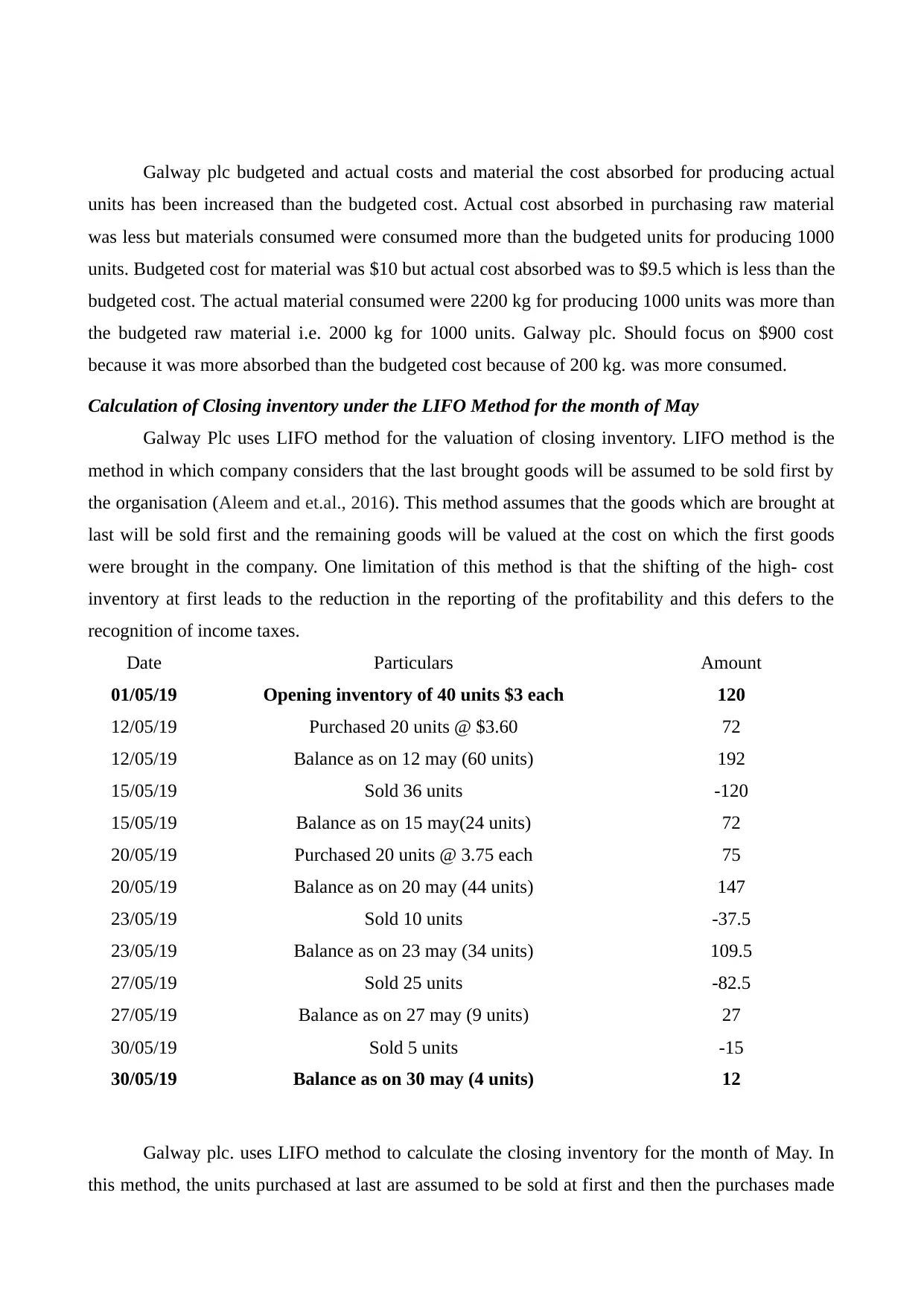
Galway plc budgeted and actual costs and material the cost absorbed for producing actual
units has been increased than the budgeted cost. Actual cost absorbed in purchasing raw material
was less but materials consumed were consumed more than the budgeted units for producing 1000
units. Budgeted cost for material was $10 but actual cost absorbed was to $9.5 which is less than the
budgeted cost. The actual material consumed were 2200 kg for producing 1000 units was more than
the budgeted raw material i.e. 2000 kg for 1000 units. Galway plc. Should focus on $900 cost
because it was more absorbed than the budgeted cost because of 200 kg. was more consumed.
Calculation of Closing inventory under the LIFO Method for the month of May
Galway Plc uses LIFO method for the valuation of closing inventory. LIFO method is the
method in which company considers that the last brought goods will be assumed to be sold first by
the organisation (Aleem and et.al., 2016). This method assumes that the goods which are brought at
last will be sold first and the remaining goods will be valued at the cost on which the first goods
were brought in the company. One limitation of this method is that the shifting of the high- cost
inventory at first leads to the reduction in the reporting of the profitability and this defers to the
recognition of income taxes.
Date Particulars Amount
01/05/19 Opening inventory of 40 units $3 each 120
12/05/19 Purchased 20 units @ $3.60 72
12/05/19 Balance as on 12 may (60 units) 192
15/05/19 Sold 36 units -120
15/05/19 Balance as on 15 may(24 units) 72
20/05/19 Purchased 20 units @ 3.75 each 75
20/05/19 Balance as on 20 may (44 units) 147
23/05/19 Sold 10 units -37.5
23/05/19 Balance as on 23 may (34 units) 109.5
27/05/19 Sold 25 units -82.5
27/05/19 Balance as on 27 may (9 units) 27
30/05/19 Sold 5 units -15
30/05/19 Balance as on 30 may (4 units) 12
Galway plc. uses LIFO method to calculate the closing inventory for the month of May. In
this method, the units purchased at last are assumed to be sold at first and then the purchases made
units has been increased than the budgeted cost. Actual cost absorbed in purchasing raw material
was less but materials consumed were consumed more than the budgeted units for producing 1000
units. Budgeted cost for material was $10 but actual cost absorbed was to $9.5 which is less than the
budgeted cost. The actual material consumed were 2200 kg for producing 1000 units was more than
the budgeted raw material i.e. 2000 kg for 1000 units. Galway plc. Should focus on $900 cost
because it was more absorbed than the budgeted cost because of 200 kg. was more consumed.
Calculation of Closing inventory under the LIFO Method for the month of May
Galway Plc uses LIFO method for the valuation of closing inventory. LIFO method is the
method in which company considers that the last brought goods will be assumed to be sold first by
the organisation (Aleem and et.al., 2016). This method assumes that the goods which are brought at
last will be sold first and the remaining goods will be valued at the cost on which the first goods
were brought in the company. One limitation of this method is that the shifting of the high- cost
inventory at first leads to the reduction in the reporting of the profitability and this defers to the
recognition of income taxes.
Date Particulars Amount
01/05/19 Opening inventory of 40 units $3 each 120
12/05/19 Purchased 20 units @ $3.60 72
12/05/19 Balance as on 12 may (60 units) 192
15/05/19 Sold 36 units -120
15/05/19 Balance as on 15 may(24 units) 72
20/05/19 Purchased 20 units @ 3.75 each 75
20/05/19 Balance as on 20 may (44 units) 147
23/05/19 Sold 10 units -37.5
23/05/19 Balance as on 23 may (34 units) 109.5
27/05/19 Sold 25 units -82.5
27/05/19 Balance as on 27 may (9 units) 27
30/05/19 Sold 5 units -15
30/05/19 Balance as on 30 may (4 units) 12
Galway plc. uses LIFO method to calculate the closing inventory for the month of May. In
this method, the units purchased at last are assumed to be sold at first and then the purchases made
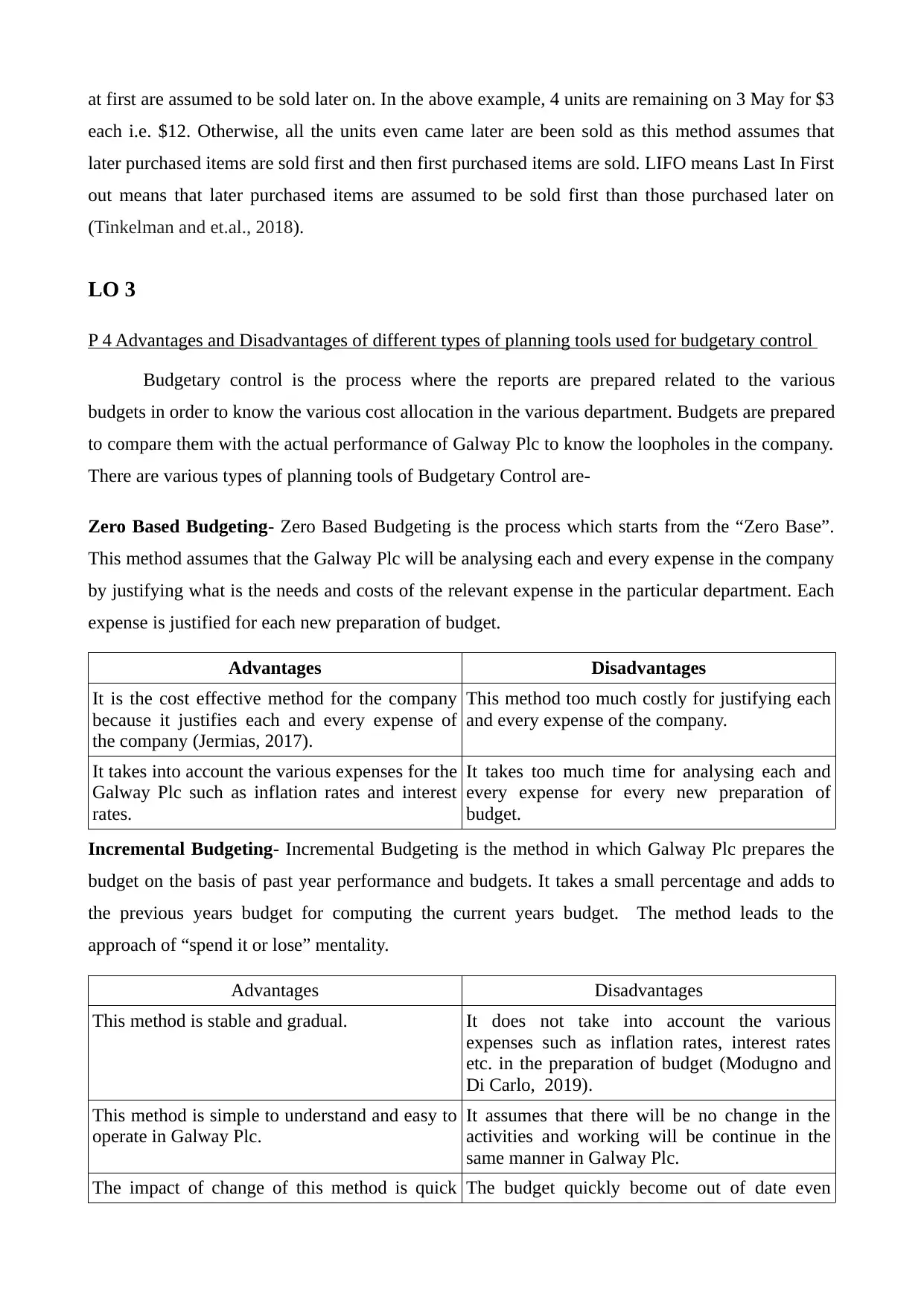
at first are assumed to be sold later on. In the above example, 4 units are remaining on 3 May for $3
each i.e. $12. Otherwise, all the units even came later are been sold as this method assumes that
later purchased items are sold first and then first purchased items are sold. LIFO means Last In First
out means that later purchased items are assumed to be sold first than those purchased later on
(Tinkelman and et.al., 2018).
LO 3
P 4 Advantages and Disadvantages of different types of planning tools used for budgetary control
Budgetary control is the process where the reports are prepared related to the various
budgets in order to know the various cost allocation in the various department. Budgets are prepared
to compare them with the actual performance of Galway Plc to know the loopholes in the company.
There are various types of planning tools of Budgetary Control are-
Zero Based Budgeting- Zero Based Budgeting is the process which starts from the “Zero Base”.
This method assumes that the Galway Plc will be analysing each and every expense in the company
by justifying what is the needs and costs of the relevant expense in the particular department. Each
expense is justified for each new preparation of budget.
Advantages Disadvantages
It is the cost effective method for the company
because it justifies each and every expense of
the company (Jermias, 2017).
This method too much costly for justifying each
and every expense of the company.
It takes into account the various expenses for the
Galway Plc such as inflation rates and interest
rates.
It takes too much time for analysing each and
every expense for every new preparation of
budget.
Incremental Budgeting- Incremental Budgeting is the method in which Galway Plc prepares the
budget on the basis of past year performance and budgets. It takes a small percentage and adds to
the previous years budget for computing the current years budget. The method leads to the
approach of “spend it or lose” mentality.
Advantages Disadvantages
This method is stable and gradual. It does not take into account the various
expenses such as inflation rates, interest rates
etc. in the preparation of budget (Modugno and
Di Carlo, 2019).
This method is simple to understand and easy to
operate in Galway Plc.
It assumes that there will be no change in the
activities and working will be continue in the
same manner in Galway Plc.
The impact of change of this method is quick The budget quickly become out of date even
each i.e. $12. Otherwise, all the units even came later are been sold as this method assumes that
later purchased items are sold first and then first purchased items are sold. LIFO means Last In First
out means that later purchased items are assumed to be sold first than those purchased later on
(Tinkelman and et.al., 2018).
LO 3
P 4 Advantages and Disadvantages of different types of planning tools used for budgetary control
Budgetary control is the process where the reports are prepared related to the various
budgets in order to know the various cost allocation in the various department. Budgets are prepared
to compare them with the actual performance of Galway Plc to know the loopholes in the company.
There are various types of planning tools of Budgetary Control are-
Zero Based Budgeting- Zero Based Budgeting is the process which starts from the “Zero Base”.
This method assumes that the Galway Plc will be analysing each and every expense in the company
by justifying what is the needs and costs of the relevant expense in the particular department. Each
expense is justified for each new preparation of budget.
Advantages Disadvantages
It is the cost effective method for the company
because it justifies each and every expense of
the company (Jermias, 2017).
This method too much costly for justifying each
and every expense of the company.
It takes into account the various expenses for the
Galway Plc such as inflation rates and interest
rates.
It takes too much time for analysing each and
every expense for every new preparation of
budget.
Incremental Budgeting- Incremental Budgeting is the method in which Galway Plc prepares the
budget on the basis of past year performance and budgets. It takes a small percentage and adds to
the previous years budget for computing the current years budget. The method leads to the
approach of “spend it or lose” mentality.
Advantages Disadvantages
This method is stable and gradual. It does not take into account the various
expenses such as inflation rates, interest rates
etc. in the preparation of budget (Modugno and
Di Carlo, 2019).
This method is simple to understand and easy to
operate in Galway Plc.
It assumes that there will be no change in the
activities and working will be continue in the
same manner in Galway Plc.
The impact of change of this method is quick The budget quickly become out of date even
⊘ This is a preview!⊘
Do you want full access?
Subscribe today to unlock all pages.

Trusted by 1+ million students worldwide
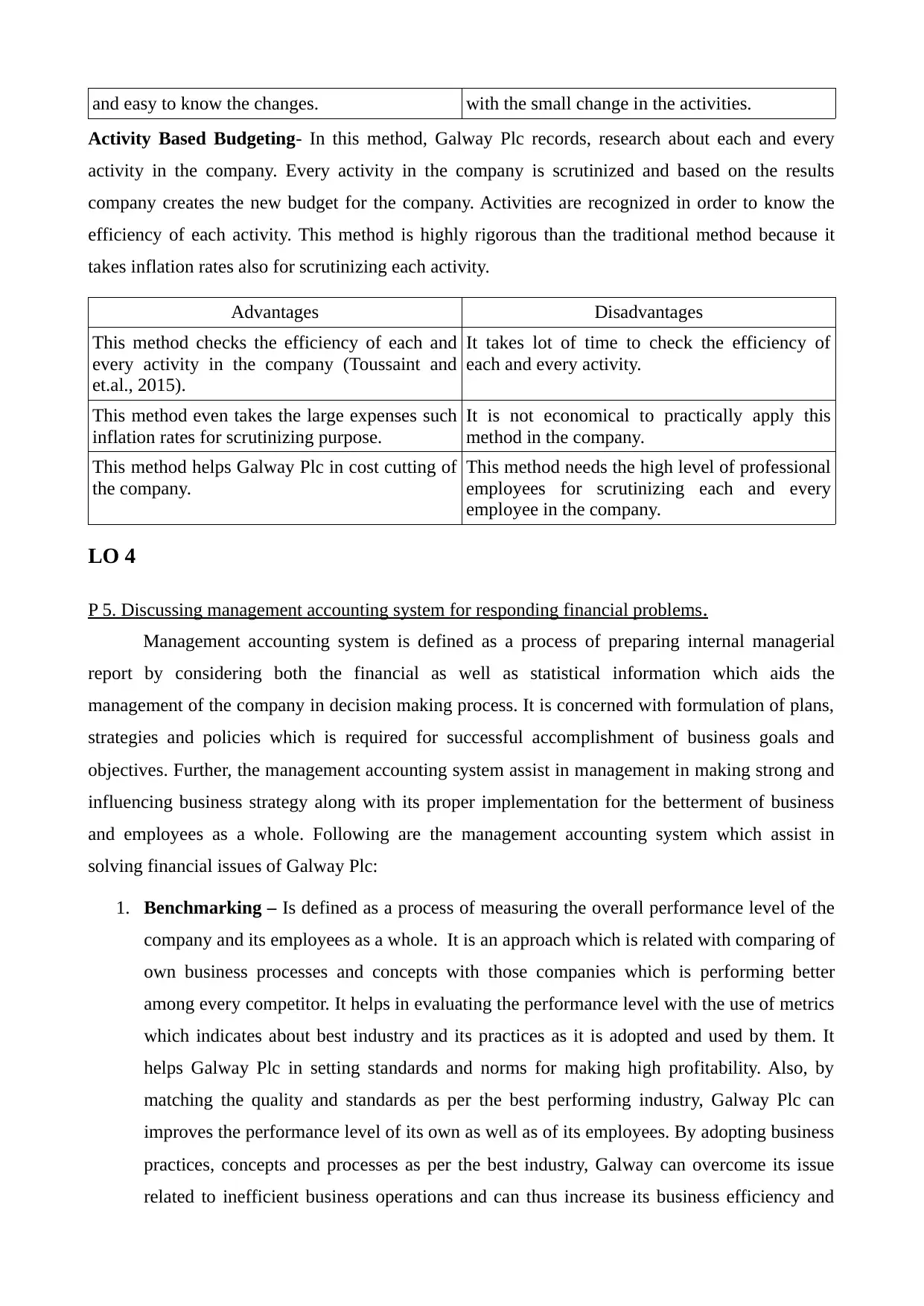
and easy to know the changes. with the small change in the activities.
Activity Based Budgeting- In this method, Galway Plc records, research about each and every
activity in the company. Every activity in the company is scrutinized and based on the results
company creates the new budget for the company. Activities are recognized in order to know the
efficiency of each activity. This method is highly rigorous than the traditional method because it
takes inflation rates also for scrutinizing each activity.
Advantages Disadvantages
This method checks the efficiency of each and
every activity in the company (Toussaint and
et.al., 2015).
It takes lot of time to check the efficiency of
each and every activity.
This method even takes the large expenses such
inflation rates for scrutinizing purpose.
It is not economical to practically apply this
method in the company.
This method helps Galway Plc in cost cutting of
the company.
This method needs the high level of professional
employees for scrutinizing each and every
employee in the company.
LO 4
P 5. Discussing management accounting system for responding financial problems.
Management accounting system is defined as a process of preparing internal managerial
report by considering both the financial as well as statistical information which aids the
management of the company in decision making process. It is concerned with formulation of plans,
strategies and policies which is required for successful accomplishment of business goals and
objectives. Further, the management accounting system assist in management in making strong and
influencing business strategy along with its proper implementation for the betterment of business
and employees as a whole. Following are the management accounting system which assist in
solving financial issues of Galway Plc:
1. Benchmarking – Is defined as a process of measuring the overall performance level of the
company and its employees as a whole. It is an approach which is related with comparing of
own business processes and concepts with those companies which is performing better
among every competitor. It helps in evaluating the performance level with the use of metrics
which indicates about best industry and its practices as it is adopted and used by them. It
helps Galway Plc in setting standards and norms for making high profitability. Also, by
matching the quality and standards as per the best performing industry, Galway Plc can
improves the performance level of its own as well as of its employees. By adopting business
practices, concepts and processes as per the best industry, Galway can overcome its issue
related to inefficient business operations and can thus increase its business efficiency and
Activity Based Budgeting- In this method, Galway Plc records, research about each and every
activity in the company. Every activity in the company is scrutinized and based on the results
company creates the new budget for the company. Activities are recognized in order to know the
efficiency of each activity. This method is highly rigorous than the traditional method because it
takes inflation rates also for scrutinizing each activity.
Advantages Disadvantages
This method checks the efficiency of each and
every activity in the company (Toussaint and
et.al., 2015).
It takes lot of time to check the efficiency of
each and every activity.
This method even takes the large expenses such
inflation rates for scrutinizing purpose.
It is not economical to practically apply this
method in the company.
This method helps Galway Plc in cost cutting of
the company.
This method needs the high level of professional
employees for scrutinizing each and every
employee in the company.
LO 4
P 5. Discussing management accounting system for responding financial problems.
Management accounting system is defined as a process of preparing internal managerial
report by considering both the financial as well as statistical information which aids the
management of the company in decision making process. It is concerned with formulation of plans,
strategies and policies which is required for successful accomplishment of business goals and
objectives. Further, the management accounting system assist in management in making strong and
influencing business strategy along with its proper implementation for the betterment of business
and employees as a whole. Following are the management accounting system which assist in
solving financial issues of Galway Plc:
1. Benchmarking – Is defined as a process of measuring the overall performance level of the
company and its employees as a whole. It is an approach which is related with comparing of
own business processes and concepts with those companies which is performing better
among every competitor. It helps in evaluating the performance level with the use of metrics
which indicates about best industry and its practices as it is adopted and used by them. It
helps Galway Plc in setting standards and norms for making high profitability. Also, by
matching the quality and standards as per the best performing industry, Galway Plc can
improves the performance level of its own as well as of its employees. By adopting business
practices, concepts and processes as per the best industry, Galway can overcome its issue
related to inefficient business operations and can thus increase its business efficiency and
Paraphrase This Document
Need a fresh take? Get an instant paraphrase of this document with our AI Paraphraser
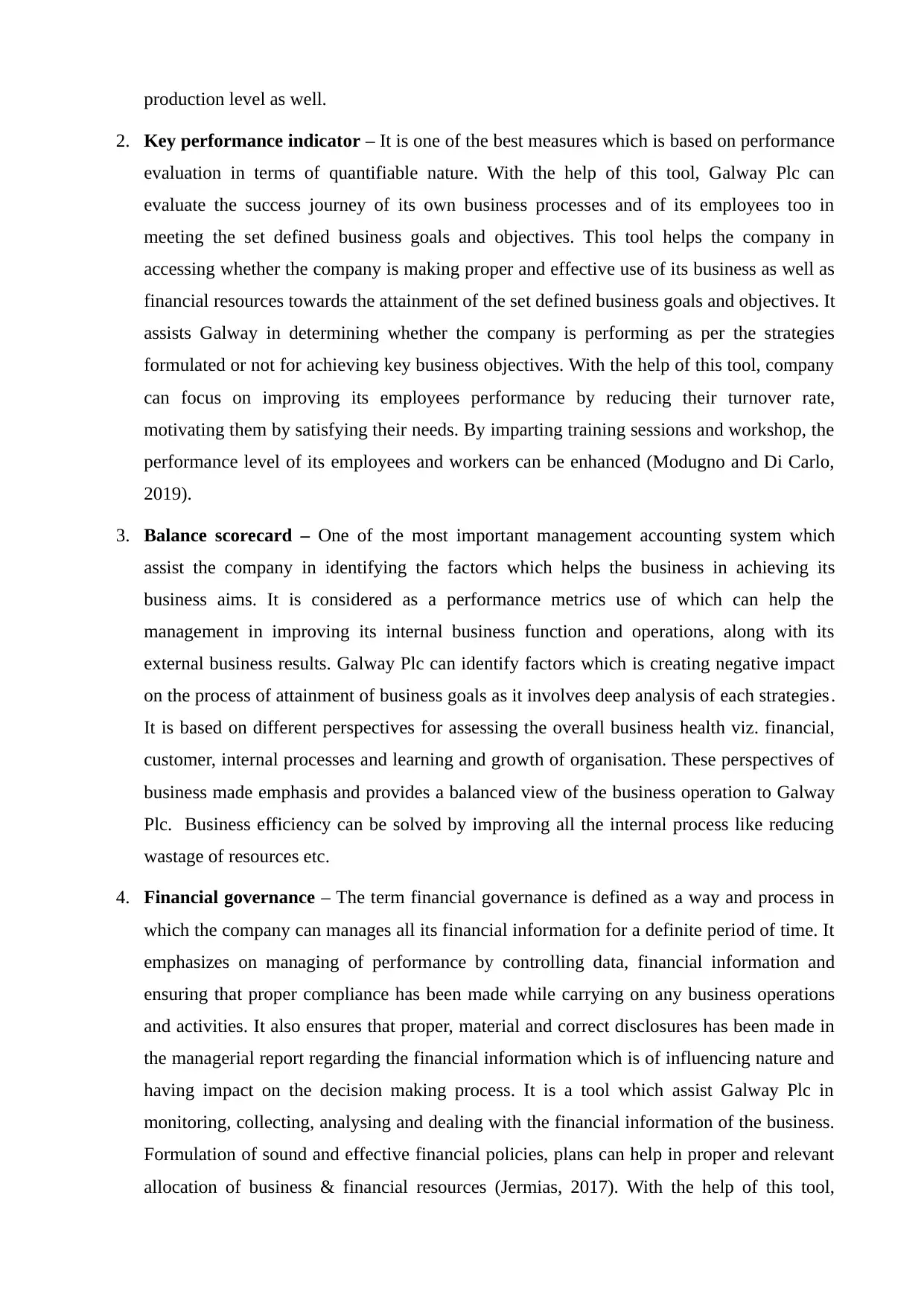
production level as well.
2. Key performance indicator – It is one of the best measures which is based on performance
evaluation in terms of quantifiable nature. With the help of this tool, Galway Plc can
evaluate the success journey of its own business processes and of its employees too in
meeting the set defined business goals and objectives. This tool helps the company in
accessing whether the company is making proper and effective use of its business as well as
financial resources towards the attainment of the set defined business goals and objectives. It
assists Galway in determining whether the company is performing as per the strategies
formulated or not for achieving key business objectives. With the help of this tool, company
can focus on improving its employees performance by reducing their turnover rate,
motivating them by satisfying their needs. By imparting training sessions and workshop, the
performance level of its employees and workers can be enhanced (Modugno and Di Carlo,
2019).
3. Balance scorecard – One of the most important management accounting system which
assist the company in identifying the factors which helps the business in achieving its
business aims. It is considered as a performance metrics use of which can help the
management in improving its internal business function and operations, along with its
external business results. Galway Plc can identify factors which is creating negative impact
on the process of attainment of business goals as it involves deep analysis of each strategies.
It is based on different perspectives for assessing the overall business health viz. financial,
customer, internal processes and learning and growth of organisation. These perspectives of
business made emphasis and provides a balanced view of the business operation to Galway
Plc. Business efficiency can be solved by improving all the internal process like reducing
wastage of resources etc.
4. Financial governance – The term financial governance is defined as a way and process in
which the company can manages all its financial information for a definite period of time. It
emphasizes on managing of performance by controlling data, financial information and
ensuring that proper compliance has been made while carrying on any business operations
and activities. It also ensures that proper, material and correct disclosures has been made in
the managerial report regarding the financial information which is of influencing nature and
having impact on the decision making process. It is a tool which assist Galway Plc in
monitoring, collecting, analysing and dealing with the financial information of the business.
Formulation of sound and effective financial policies, plans can help in proper and relevant
allocation of business & financial resources (Jermias, 2017). With the help of this tool,
2. Key performance indicator – It is one of the best measures which is based on performance
evaluation in terms of quantifiable nature. With the help of this tool, Galway Plc can
evaluate the success journey of its own business processes and of its employees too in
meeting the set defined business goals and objectives. This tool helps the company in
accessing whether the company is making proper and effective use of its business as well as
financial resources towards the attainment of the set defined business goals and objectives. It
assists Galway in determining whether the company is performing as per the strategies
formulated or not for achieving key business objectives. With the help of this tool, company
can focus on improving its employees performance by reducing their turnover rate,
motivating them by satisfying their needs. By imparting training sessions and workshop, the
performance level of its employees and workers can be enhanced (Modugno and Di Carlo,
2019).
3. Balance scorecard – One of the most important management accounting system which
assist the company in identifying the factors which helps the business in achieving its
business aims. It is considered as a performance metrics use of which can help the
management in improving its internal business function and operations, along with its
external business results. Galway Plc can identify factors which is creating negative impact
on the process of attainment of business goals as it involves deep analysis of each strategies.
It is based on different perspectives for assessing the overall business health viz. financial,
customer, internal processes and learning and growth of organisation. These perspectives of
business made emphasis and provides a balanced view of the business operation to Galway
Plc. Business efficiency can be solved by improving all the internal process like reducing
wastage of resources etc.
4. Financial governance – The term financial governance is defined as a way and process in
which the company can manages all its financial information for a definite period of time. It
emphasizes on managing of performance by controlling data, financial information and
ensuring that proper compliance has been made while carrying on any business operations
and activities. It also ensures that proper, material and correct disclosures has been made in
the managerial report regarding the financial information which is of influencing nature and
having impact on the decision making process. It is a tool which assist Galway Plc in
monitoring, collecting, analysing and dealing with the financial information of the business.
Formulation of sound and effective financial policies, plans can help in proper and relevant
allocation of business & financial resources (Jermias, 2017). With the help of this tool,
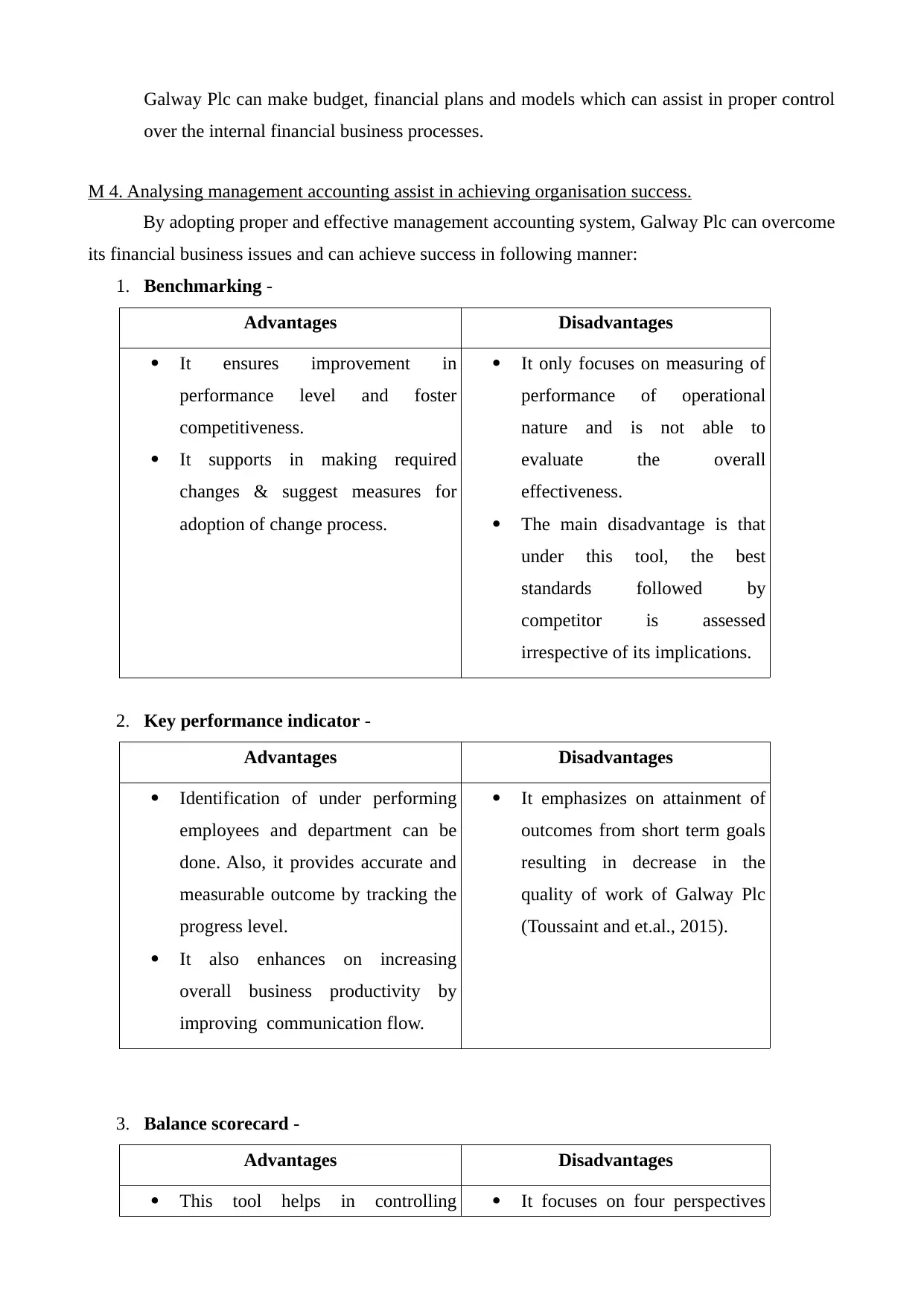
Galway Plc can make budget, financial plans and models which can assist in proper control
over the internal financial business processes.
M 4. Analysing management accounting assist in achieving organisation success.
By adopting proper and effective management accounting system, Galway Plc can overcome
its financial business issues and can achieve success in following manner:
1. Benchmarking -
Advantages Disadvantages
It ensures improvement in
performance level and foster
competitiveness.
It supports in making required
changes & suggest measures for
adoption of change process.
It only focuses on measuring of
performance of operational
nature and is not able to
evaluate the overall
effectiveness.
The main disadvantage is that
under this tool, the best
standards followed by
competitor is assessed
irrespective of its implications.
2. Key performance indicator -
Advantages Disadvantages
Identification of under performing
employees and department can be
done. Also, it provides accurate and
measurable outcome by tracking the
progress level.
It also enhances on increasing
overall business productivity by
improving communication flow.
It emphasizes on attainment of
outcomes from short term goals
resulting in decrease in the
quality of work of Galway Plc
(Toussaint and et.al., 2015).
3. Balance scorecard -
Advantages Disadvantages
This tool helps in controlling It focuses on four perspectives
over the internal financial business processes.
M 4. Analysing management accounting assist in achieving organisation success.
By adopting proper and effective management accounting system, Galway Plc can overcome
its financial business issues and can achieve success in following manner:
1. Benchmarking -
Advantages Disadvantages
It ensures improvement in
performance level and foster
competitiveness.
It supports in making required
changes & suggest measures for
adoption of change process.
It only focuses on measuring of
performance of operational
nature and is not able to
evaluate the overall
effectiveness.
The main disadvantage is that
under this tool, the best
standards followed by
competitor is assessed
irrespective of its implications.
2. Key performance indicator -
Advantages Disadvantages
Identification of under performing
employees and department can be
done. Also, it provides accurate and
measurable outcome by tracking the
progress level.
It also enhances on increasing
overall business productivity by
improving communication flow.
It emphasizes on attainment of
outcomes from short term goals
resulting in decrease in the
quality of work of Galway Plc
(Toussaint and et.al., 2015).
3. Balance scorecard -
Advantages Disadvantages
This tool helps in controlling It focuses on four perspectives
⊘ This is a preview!⊘
Do you want full access?
Subscribe today to unlock all pages.

Trusted by 1+ million students worldwide
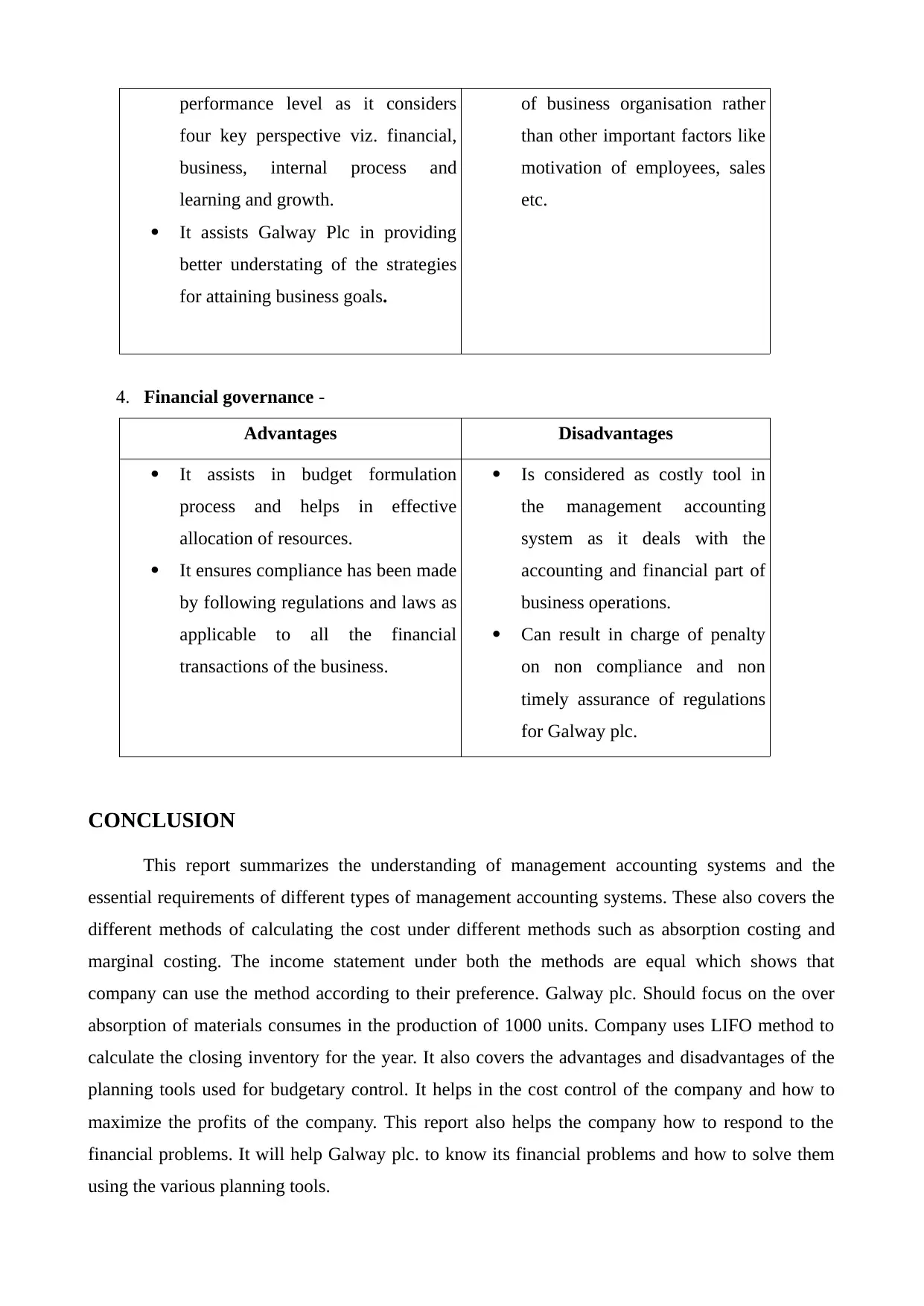
performance level as it considers
four key perspective viz. financial,
business, internal process and
learning and growth.
It assists Galway Plc in providing
better understating of the strategies
for attaining business goals.
of business organisation rather
than other important factors like
motivation of employees, sales
etc.
4. Financial governance -
Advantages Disadvantages
It assists in budget formulation
process and helps in effective
allocation of resources.
It ensures compliance has been made
by following regulations and laws as
applicable to all the financial
transactions of the business.
Is considered as costly tool in
the management accounting
system as it deals with the
accounting and financial part of
business operations.
Can result in charge of penalty
on non compliance and non
timely assurance of regulations
for Galway plc.
CONCLUSION
This report summarizes the understanding of management accounting systems and the
essential requirements of different types of management accounting systems. These also covers the
different methods of calculating the cost under different methods such as absorption costing and
marginal costing. The income statement under both the methods are equal which shows that
company can use the method according to their preference. Galway plc. Should focus on the over
absorption of materials consumes in the production of 1000 units. Company uses LIFO method to
calculate the closing inventory for the year. It also covers the advantages and disadvantages of the
planning tools used for budgetary control. It helps in the cost control of the company and how to
maximize the profits of the company. This report also helps the company how to respond to the
financial problems. It will help Galway plc. to know its financial problems and how to solve them
using the various planning tools.
four key perspective viz. financial,
business, internal process and
learning and growth.
It assists Galway Plc in providing
better understating of the strategies
for attaining business goals.
of business organisation rather
than other important factors like
motivation of employees, sales
etc.
4. Financial governance -
Advantages Disadvantages
It assists in budget formulation
process and helps in effective
allocation of resources.
It ensures compliance has been made
by following regulations and laws as
applicable to all the financial
transactions of the business.
Is considered as costly tool in
the management accounting
system as it deals with the
accounting and financial part of
business operations.
Can result in charge of penalty
on non compliance and non
timely assurance of regulations
for Galway plc.
CONCLUSION
This report summarizes the understanding of management accounting systems and the
essential requirements of different types of management accounting systems. These also covers the
different methods of calculating the cost under different methods such as absorption costing and
marginal costing. The income statement under both the methods are equal which shows that
company can use the method according to their preference. Galway plc. Should focus on the over
absorption of materials consumes in the production of 1000 units. Company uses LIFO method to
calculate the closing inventory for the year. It also covers the advantages and disadvantages of the
planning tools used for budgetary control. It helps in the cost control of the company and how to
maximize the profits of the company. This report also helps the company how to respond to the
financial problems. It will help Galway plc. to know its financial problems and how to solve them
using the various planning tools.
Paraphrase This Document
Need a fresh take? Get an instant paraphrase of this document with our AI Paraphraser

1 out of 14
Related Documents
Your All-in-One AI-Powered Toolkit for Academic Success.
+13062052269
info@desklib.com
Available 24*7 on WhatsApp / Email
![[object Object]](/_next/static/media/star-bottom.7253800d.svg)
Unlock your academic potential
© 2024 | Zucol Services PVT LTD | All rights reserved.





